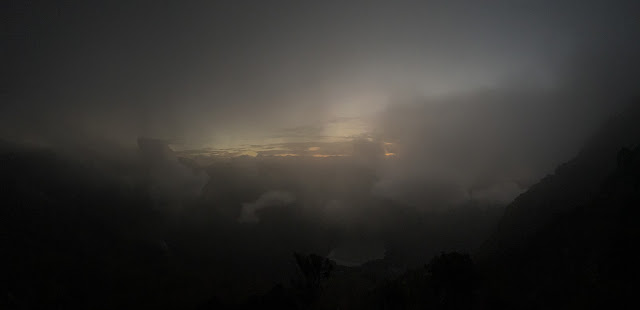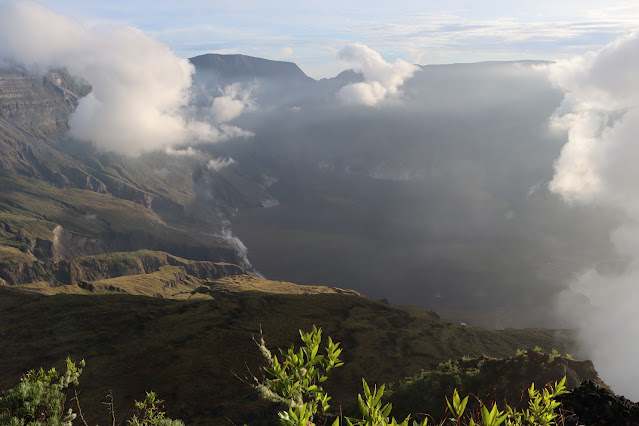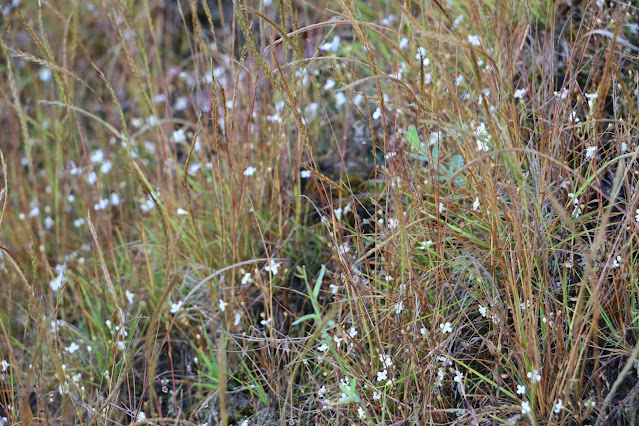Summit on the western rim of the huge cater of Mount Tambora on the Indonesian island of Sumbawa. May 20, 2022.
A some point in the first decade of this century I wrote the introductory pages to my manuscript about the History of The Church of Jesus Christ of Latter-day Saints in Indonesia. Here is what I wrote:
The island of
Sumbawa lays three islands to the east of Java, beyond Bali and Lombok. It,
like many of the other islands of the Indonesian archipelago, was formed
through eons of volcanic eruptions as the power, pressure and heat of the
Australian plate subducting under the Eurasian plate forced molten material up
through the earth’s cracked curst. One of the most violent of these eruptions
was the 1815 explosion of Sumbawa’s Mt. Tambora.
Tambora’s eruption
is considered to be the second largest in history. It killed as many as 50,000
people, wiped out a whole language (Tambora) and left the island of Sumbawa
uninhabitable for years. The force of its explosion sent a staggering 11 cubic
miles of dust, ash and rock into the atmosphere! (By comparison, the famous1883
eruption of Krakatoa to the west of Java only ejected six cubic miles of
mountain.) Prevailing winds then enveloped the earth with particulates that blocked
out the warming rays of the sun and thus lowered the world’s temperature by an
average of one degree Celsius. This “year without summer” brought agriculture
calamity to Europe and North America.
In his biography
of Mormon Church founder Joseph Smith, Richard Bushmen has this to say about
Tambora’s far reaching influence on the farmers of New England, including the
Smith family of Vermont:
“In the next two
years nature conspired to drive [the Smith Family] from Vermont. The second
year on the Norwich farm, crops failed again. Joseph [Smith Sr.] planted the
third spring, in 1816, with the resolve to try just once more. The result was
conclusive. This was known as the year without a summer. Lucy [Smith] spoke of
an ‘untimely frost.’ Actually on June 8 several inches of snow fell all across
the highlands of northern New York and New England, and ice formed on the
ponds. The entire summer was cold and dry. Famine compelled farmers to pay $3 a
bushel for imported corn. As Lucy remembered it, ‘This was enough: my husband
was now altogether decided upon going to New York.’”
The Smith family
was not alone. Over the next two years thousands of Vermonters migrated in
search of literal greener pastures. For the Smith family the greener pasture
was the town of Palmyra in western upstate New York. It was here, a few years
later that a young Joseph Smith Jr. was directed by the angel Moroni to the
Hill Cumorah to unearth golden plates that contained a record of ancient
peoples and prophets who lived in the Americas. Joseph Smith translated the
record and called it the Book of Mormon.
Had Tambora not
erupted, there would not have been a year without summer, and without that cold,
dry summer the Smith family may have stayed put in Vermont thus leaving Joseph
far from Cumorah and its buried plates. Certainly other factors could have
compelled the Smith family to migrate, but for some reason a volcano on an
isolated island in the Dutch East Indies served as the catalyst to put a
religiously inquisitive boy in the right place to receive the records and to
begin a religious restoration.
Then in 2018 The Church published the first of its four volume history of the church entitled Saints.
"In 1815, the
Indonesian island of Sumbawa was lush and green with recent rain.
Families were preparing for the dry season ahead, as they had every year
for generations, cultivating rice paddies in the shadow of a volcano
called Tambora.
On
April 5, after decades of slumber, the mountain roared awake, coughing
up ash and fire. Hundreds of miles away, witnesses heard what sounded
like cannon fire. Small eruptions continued for days. Then, on the
evening of April 10, the whole mountain exploded. Three fiery plumes
shot skyward, merging into one massive blast. Liquid fire flowed down
the mountainside, enveloping the village at its base. Whirlwinds raged
through the region, pulling up trees and sweeping away homes.1
...
The eruption of Tambora affected weather in North America through the
following year. Spring gave way to snowfall and killing frosts, and 1816
passed into memory as the year without a summer.
6
In Vermont, in the northeast corner of the United States, rocky hills
had frustrated a farmer named Joseph Smith Sr. for years. But that
season, as he and his wife, Lucy Mack Smith, watched their crops shrivel
under the relentless frosts, they knew they faced financial ruin and an
uncertain future if they stayed where they were.
...
The following winter, Joseph Jr. hobbled through the snow with his
mother, brothers, and sisters. They were on their way west to a New York
village named Palmyra, near where Joseph Sr. had found good land and
was waiting for his family."
Dang, my delayed writing meant that the Church got to lead with the Tambora-compels-the-Smith-family-to-move-to-Palmyra story.
Luckily another angle for my introduction emerged in December 2019 that linked the eruption of Tambora and the beginnings of the Church in America with the beginnings of the Church in Indonesia. From a new draft of my introduction chapter:
"In December 2019,
Aischa and Juswan Tadiman from Jakarta (he the coordinator for the Church
Education System in Asia and the patriarch of the Jakarta Stake and she a
translator for the church) and their four daughters, Bianca, Vanessa, Priscilla
and Patricia (all graduates or attendees at BYU-Provo or BYU-Hawaii) set out to
climb Tambora. It was to be the culminating adventure in a year when members of
the church had been commemorating the fiftieth anniversary of the dedication of
Indonesia for the preaching of the gospel (in October 1969 by Elder Ezra Taft
Benson) and the arrival of the first six missionaries in Jakarta (in January 1970).
Within a year of those events, Juswan’s parents and six children would join the
church. A few years later teenager Aischa Meyer and her mother and brother
would also be baptized.
The Tandiman’s expedition
required significant coordination. It was rare to have all six members of the
family in Jakarta at the same time. Bianca had a job in San Francisco and for
years there had been parade of daughters flying off to Provo or Laie for
college. Of more impending concern, was the advent of the rainy season which meant
the climb might have to be aborted if the mountain became shrouded in clouds
and rain. Undaunted, they pressed forward in faith.
On the morning of December
19 they flew to Sumbawa where they met their two guides. They then drove five
hours and nearly halfway around the island to the expansive base of Tambora. There
they registered for the climb and transferred to off-road vehicles that would take
them part way up the mountain. They could see rainclouds surrounding the
mountaintop.
That night they
camped at Post 3 at an elevation of 1,800 meters. After dinner the two guides
shared with the Tandimans, some of the history of the Tambora. They focused on
the 1815 eruption and the subsequent year without summer which they explained changed
the climate of the earth, helped Napoleon win a war and inspired the invention
of the bicycle when horse feed became scarce. The dark and stormy weather of
the cold year also inspired Mary Shelly’s writing of Frankenstein.
It was then the
Tandimans’ turn to explain what they knew about Tambora and the year without summer.
They related how the Tambora-caused frosty summer weather in New England compelled
a family named Smith to migrate to New York where their son Joseph was led by
an angel to an ancient religious record engraved upon plates that Joseph then
translated and published as the Book of Mormon. In a Liahona article describing
their adventure, Aischa wrote: “It was an amazing feeling to share this truth”
while camped on the slopes “of Mt. Tambora itself.”
To their surprise
and blessing, morning brought clear skies for the 4:00 AM departure and the three-hour
climb to the summit. There the Tandimans unfurled a banner proclaiming: “The
Church of Jesus Christ of Latter-day Saints. 50 Years in Indonesia. Rise and Shine”.
They also listened to a recording of Truth Forever More—the Indonesian mission
song that describes the coming of the restored gospel to the isles of the sea
in Indonesia.Then they then took a jump
photo at the edge of the caldera while holding a placard indicating that the summit
was 2423 meters above sea level. When they arrived back at Post 3 they noticed
that rain clouds had once again enveloped the summit. Later that day when they returned to a hotel
near the airport, the Tandimans presented their two guides with copies of the Book
of Mormon.
.jpg)
.jpg)
.jpg)
Thanks to Juswan and Aischa for sharing some of their photos from their trek.
The Tandiman's pilgrimage inspired me. I don't know of any other Latter-day Saints who have climbed Tambora either for the adventure or to recognize the important role this volcano played in helping to bring about the restoration. I put a possible trip to Tambora in the back of my mind.
Before COVID Dr. Dan Olsen and I decided to put together a geography study aboard to Asia. We planned to visit Indonesia, Thailand, Cambodia, Vietnam and Japan. We were delayed two years but finally this year we were allowed to start making plans. But then because of the Delta variant, BYU decided to limit all study abroads to just one country. We regrouped. Frist our plan was to just visit Bali and Java due to interisland demands of testing and a need for ready access to health care. Our plan included five days of quarantine in a hotel in Bali. About a month out from our departure date, Indonesia dropped its quarantine requirement. All at once we had five extra days. I first tried to figure out a way to visit Papua (too isolated and limited health care) then I tried to figure out how to get in and out of the Banda Islands (the original spice islands and very high on my list of a place to visit), but getting there was a transportation nightmare. Finally the thought occurred to me, hey, we could do Tambora! It would fit nicely with the other seismic places we planned to visit. I e-mailed the Tandiman's and they shared their schedule and contacts, I emailed Brother Sihol Manullang (Oballi Tours) in Bali to see if he could arrange something. He could. We got a quote and a sample itinerary. It was a go. We purchased tickets for a flight from Bali to Bima. Then I asked Sihol to order a banner for us. I thought 1 meter by 3 meters would be about right, but I mistakenly emailed him 1 meter by 9 meters. Yikes, It was big (see first photo).

After three days of acclamation in Bali when flew on a Wings Arline flight from Bali to Lombok and then to Bima, Sumbawa, There we were met by Yan and Syaf--our guides. It was a four hour drive to the isolated center peninsula of Sumbawa.
source:
https://www.gunungbagging.com/tambora/
There are two main options for climbing Tambora. Start at the northwest in Pancacsila and hike it in 1-3 days or start from the south in Doro Ncanga and ride jeeps (about a three hour bumpy ride) two thirds up the mountain, camp for the night in Pos 3 and then hike the reminder of the route the next morning. The hiking portion takes about two hours. We chose option two because of the shortened time.
Source:
https://visittambora.com/tambora-guesthouse/
Our starting point at the entrance to the national park. Tambora's flat top looms in the distance.
On this study aboard we will visit Toba, Tambora, Krakatau, Agung and Merapi.
Will and I rode in a 1976 Toyota Landcruiser that has been kept running all these years by a master mechanic and driver.

It was a long, bumpy ride. The second of the three jeeps (called hard tops by the locals) seemed to have lost part of its four wheel drive and so it had a hard time making it up some of the steep climbs through soft crumbly lava gravel. Our Land Cruiser was following so several times both jeeps were emptied of their passengers and we all hiked up the steep inclines to wait for the jeeps to finally make it. The mechanical and rough road delays added 2 1/2 extra hours. We finally arrived at Pos 3 at around midnight. The crew pitched tents on the raised wood floors of the covered pavilions where we all then slept (roughly for me) until 3:00. After a quick breakfast of Nutella sandwiches we departed at 3:30. Will was in the vanguard group of four students and two guides that made it to the top just in time for sunrise. Others of us were slower. It was an alternating rocky, slippery, loose, not-always-a-well-marked trail. I was happy I hauled hiking poles to Indonesia which really helped me (and one other who used one of mine) stay steady on the dark hike up and then save my knees on the way down. Head lamps were essential. Not all had one so I hiked close by one in the group to help them see the way.

From the summit. Photo by Will
First four on top: Courtney, McKay, Will, Luke
Four photos by Will
I was in the second wave. This was my fist view down into the crater. It is huge! What once filled the cater became the particulates the enveloped the earth and cooled its climate.
Professor Dan Olson
Steam vents.
Telling our guide Yan about the Smith family's migration.
And just like that clouds dissipated and we could see across the crater.
Such an awesome view. Notice the rest of the group on the far left.
Looking southwestward down the slope and out to the western side of the peninsula.
We folded the banner in half for another photo.
Klaesara giving her site report about Tambora and the Restoration. I then added some more information from my own research.
Will heading down.
The whole group strung out across the beautiful hill side.
Yan bringing up the rear.
Part of the trail--rough, rocky and slippery from the nighttime dew and a few sprinkles.
Another part of the trail covered in soft, loose, basalt sand/gravel. Both we not always easy to navigate.
Sometimes the seldom traversed trail passed through grass that grows among the hidden basalt boulders. Also treacherous.
The double track jeep trail that winds through the tall grass up to Pos 3.
Pos 3 where the jeep path and foot path meet.
After a welcome meal of fried chicken and rice we were ready for our drive down. Syaf on the far right is an English teacher for his regular job and a trek entrepreneur on the side.
Once back at the park headquarter building, We had another meal of rice, chicken and veggies and then we drove back to Bima where we had Padang food and all tried martabak manis before collapsing into bed. in a nice new hotel.
I'm not sure what the students thought of this adventure. I heard no murmuring and all seemed excited to reach the top, but there was maybe not the same level of enthusiasm as the Tandimans and I felt. Maybe I have become so drawn to this far off place because of my long involvement with Indonesia, and my having taught, researched and written about seismic events and places in Indonesia.
I'm hoping that these two pilgrimages to Tambora might foster a new addition to the list of Mormon Historical Sites. Yan, Syaf , Sihol (who has the banner for any who want to borrow it) and myself would be happy to help lead you there.


.jpg)
.jpg)
.jpg)
.jpg)

































































TERIMAKASIH, Chad! This brings back precious memories from our family's hike! LOVE LOVE LOVE the banner!
ReplyDeleteOn day you must show me Indonesia. I can't wait.
ReplyDelete